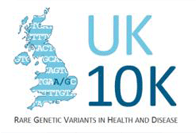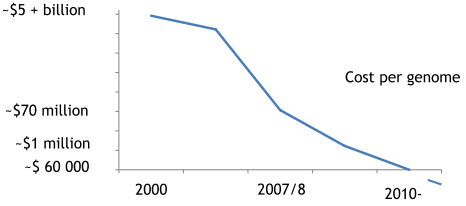Genome sequencing at Children of the 90s
As you know, we are planning to look in more detail at the differences in our genes and how they relate to both health and disease. The aim of this type of work is to find changes in genes that are associated with complex human characteristics like growing up, behaviour, common diseases (such as obesity and diabetes) and more rare genetic conditions. For this we require your permission to use the DNA we have already collected from you and used in previous studies.
The first major project taking this approach that we are involved in is called “UK10K”. This is an exciting initiative being led by researchers at the Wellcome Trust Sanger Centre in Cambridge. In this project, the researchers (including us!) are aiming to collect whole genome data on thousands of participants, some with disease and some (like The Children of the 90s) from the normal population.
What is UK10K?
The UK10K project will enable researchers in the UK and beyond to better understand the link between low-frequency and rare genetic changes, and human disease caused by harmful changes to the proteins the body makes.
Although many hundreds of genes that are involved in causing disease have already been identified, it is believed that many more remain to be discovered. The UK10K project aims to help uncover them by studying the genetic code of 10,000 people in much finer detail than ever before.
Project Design
Not all genetic changes are harmful or lead to disease, so the project is taking a two-pronged approach to identify rare variants and their effects:
- by studying and comparing the DNA of 4,000 people whose physical characteristics are well documented, the project aims to identify those changes that have no discernable effect and those that may be linked to a particular disease
- by studying the changes within protein-coding areas of DNA that tell the body how to make proteins of 6,000 people with extreme health problems and comparing them with the first group, it is hoped to find only those changes in DNA that are responsible for the particular health problems observed.
(words from the UK10K website)
This work is also interesting for The Children of the 90s as it proposes to provide data to the academic community in a way new to our study. As previously, all genetic data will be anonymised by study number and protected, however we plan to allow researchers to access these data and a selection of physical measures by a secure and centrally managed access system administered by the Wellcome Trust. This will take the form of a restricted access database that will be managed by a separate committee with equivalent rules to those already used by The Children of the 90s to protect data.
The difference here is that your data will be available to the research community in a way that helps us to play a greater part in scientific research. Associated physical data will also be anonymised and will only be shared with other bona-fide scientists via a controlled independent committee. Importantly, it will not be possible for you to be personally identified by third parties through the genetic or clinical data stored on this database or in any resulting publications.
Remember: We remove your personal details from the data and replace them with a unique anonymous code number – like a barcode. Researchers don't need your personal details and will never see them.
Genomes and genetic data
What are our genomes and why are we interested?
Our genomes are the complete set of genetic information within our bodies. Like the maps to our very make up, the genome of every person contains the genes that code for the building blocks of our physical being and also the un-translated genetic language that lies in between them. There are over three billion letters to this genetic instruction book in our bodies and whilst we are aware of the presence of genes and their ability to code for the proteins that contribute to the way we are, this represents only around 1% of all of the information squeezed into the heart of all of our cells and does not help us understand the importance of differences in people’s genomes.
“Genome” is the word used to describe all of this information (i.e. not just the genes) and is increasingly the focus of our attention in trying to understand human biology. Over years of research into the way in which variation in our genomes from person to person is related to our health and disease, it is becoming clear that only through the measurement of genomes in their entirety will we begin to understand completely the role of genetics in the way we are.
Why can we measure our genomes better now than previously?
Genetic research as we are familiar with is has been going on for well over 100 years. In this time, great advances in the understanding of the physical properties of our genome have allowed scientists to explore it and to ask questions about the role of genetics in the way we are. However, only very recently have researchers been able to consider the genome as awhole and how the different parts of it and different ways that is varies between people might influence health and disease.
The first complete map of the human genome was written out in the year 2000 and initiated the era of the genome. Since this time there have been amazing advances in the understanding and measurement of genetic data. The rapid changes in technology have now allowed for the collection of information across the whole genome of many people within studies such as The Children of the 90s. As a result of this reduction of costs and availability of technology, we are now in a position to develop our understanding of genetics and how this might sit alongside our other sources of biological knowledge in the aim to understand both how we are healthy and how we become likely to be unhealthy.
Technology and our genomes!

New technology like these glass array chips and genome sequencer has allowed us to move from the assessment of parts of our genome in isolation to the whole thing at once. Like parts of a jigsaw, the ability to work with the whole genome instead of just parts of it will allow us to begin to understand the complete picture of the role of genes in health and disease.

This has been facilitated by the vast drops in price that have also come with the development of these technologies. Where the collection of one genome once cost billions of dollars, it is now affordable and when collected in studies like ALSPAC will allow for new and exciting research into the biology of health and disease.

What this new work is all about
We have been looking at common variations of genes across your genome (all of your genetic information) and work using this information has been very successful. However with new technology it is possible to look in much greater detail at the whole genome to identify rarer and more complete patterns of genetic variation which may be important to our health and disease.
We would like to look at these variations in the DNA of participants of the Children of the 90s population and with your permission, play an active role in the study of this and its relevance to health and disease.
Results generated from this genetic analysis will be vital to scientific research, although most of the information will have no relevance to any individual. It is possible that some specific genes that are associated with rare diseases may be identified within a specific person, but the laboratories performing the work are not accredited to provide clinical results and advice, so we will not be providing any individual feedback from this sequencing analysis. All publications based on this research will be available on our website and will be summarized in regular newsletters.
Who is funding the work on genomes in the Children of the 90s?
There are three major funders of The Children of the 90s study as a whole who are responsible for allowing us to keep going. These are the University of Bristol, the Medical Research Council (who get money from the government) and The Wellcome Trust (who are an independent funder of science in the UK). Of these, the Wellcome Trust will be funding the initial collection of sequence data, though this may change over time. Importantly, The Wellcome Trust will be responsible for the managed access of data that we make available to the research community. They will be checking who is using Children of the 90s data and how, and making sure our standards of protection and data handling are upheld. More information about these funding bodies can be found at the websites: